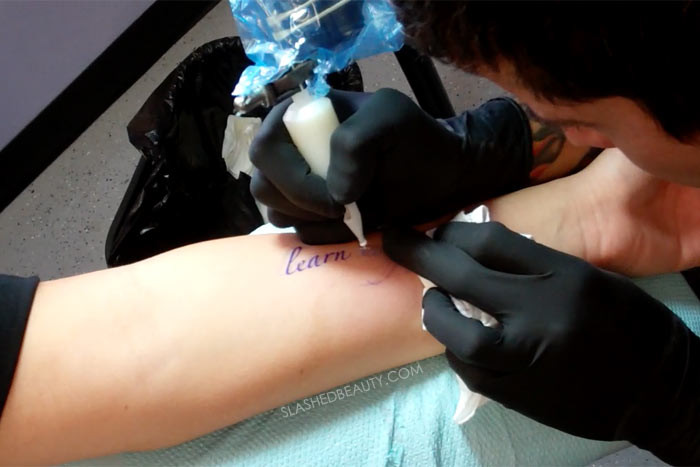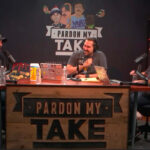White ink tattoos have carved a unique niche in the world of body art, offering a subtle yet striking alternative to traditional dark inks. Their delicate appearance and understated elegance appeal to those seeking a more discreet form of self-expression. However, the realm of tattoo artistry extends far beyond monochrome. Color tattoos bring vibrancy and dynamism to the skin, allowing for intricate designs and vivid storytelling. Whether you’re drawn to the ethereal whisper of white ink or the bold declaration of color, understanding the nuances of both is crucial in making the right choice for your skin and style.
 Close-up shot of a white ink tattoo on forearm, showcasing its subtle appearance against skin.
Close-up shot of a white ink tattoo on forearm, showcasing its subtle appearance against skin.
The Subtlety and Allure of White Ink Tattoos
White ink tattoos possess an undeniable mystique. Unlike their boldly colored counterparts, they whisper rather than shout. This inherent subtlety is a major draw for many. For individuals in professional environments or those who prefer a less conspicuous form of body art, white ink offers a way to express themselves without overt visibility. Imagine delicate white lines tracing floral patterns, geometric shapes subtly adorning wrists, or meaningful words etched in an almost invisible script. The beauty of white ink lies in its understated nature, revealing itself in glances and under certain lighting, creating an intimate and personal experience for both the wearer and those who notice it.
One of the most frequently cited advantages of white ink tattoos is their uniqueness. While color tattoos are ubiquitous, white ink remains a less common choice, contributing to its distinctive appeal. Opting for white ink can be a statement in itself, setting you apart from the mainstream and highlighting your appreciation for unconventional beauty. This rarity adds to the allure, making a white ink tattoo feel like a hidden gem, a secret piece of art carried on the skin.
Furthermore, the way white ink fades over time can be perceived as a benefit. Instead of disappearing entirely, white ink tends to soften into a fleshy tone, becoming even more integrated with the skin. For those hesitant about the permanence of tattoos, this fading quality can be reassuring. It’s a gentle evolution rather than a stark disappearance, offering a softer, more organic transition over the years. This characteristic can be particularly appealing for first-time tattoo recipients, offering a less daunting entry into the world of body modification.
Navigating the Challenges of White Ink
Despite their captivating qualities, white ink tattoos come with their own set of considerations. One of the primary hurdles is finding an experienced artist. Working with white ink requires a specialized skill set. The pigment’s thicker consistency and translucent nature demand a different approach compared to traditional colored inks. Artists need to be adept at preventing stencil ink from muddying the white, ensuring precise application to avoid a raised or scarred appearance, and understanding how white ink interacts with various skin tones. It’s essential to seek out artists with a proven portfolio of successful white ink tattoos, demonstrating their expertise and familiarity with this unique medium.
Another crucial aspect is the fading factor. While the subtle fade can be a pro for some, it’s undeniably a con if you desire a tattoo that retains its stark white vibrancy indefinitely. White ink is known to fade on all skin tones, though the degree and speed can vary. Generally, white ink tattoos tend to last longer and maintain their brightness on paler skin tones due to less melanin interference. However, regardless of skin tone, some fading is inevitable. Understanding this natural progression is key to having realistic expectations and appreciating the evolving beauty of a white ink tattoo.
A common misconception associated with white ink tattoos is their potential to be mistaken for scars. Due to their raised texture, especially when freshly done, and their subtle appearance, they can sometimes be misconstrued as scar tissue, particularly self-harm scars. While this is not always the case, and often depends on the design and placement, it’s something to be aware of, especially in social or professional contexts where misinterpretations might arise.
 Artist carefully tattooing a white ink design over a stencil on a client's arm.
Artist carefully tattooing a white ink design over a stencil on a client's arm.
Embracing the Spectrum of Color Tattoos
While white ink whispers, color tattoos sing. They inject life, vibrancy, and a wide spectrum of expression into body art. Color tattoos utilize a vast array of pigments to create visually stunning designs, ranging from bold and saturated hues to delicate watercolor washes. They allow for intricate detailing, realistic portrayals, and the depiction of depth and dimension that is often challenging to achieve with monochrome inks alone.
The world of color tattoos is incredibly diverse, offering styles to suit every aesthetic preference. Traditional color tattoos are characterized by bold outlines and solid, vibrant colors, often featuring classic motifs like roses, anchors, and eagles. Neo-traditional color tattoos build upon this foundation, incorporating finer lines, more nuanced shading, and a broader color palette for a contemporary take on classic designs. Watercolor tattoos mimic the delicate washes of watercolor paintings, using soft, blended colors to create ethereal and artistic effects. Realism color tattoos strive for photographic accuracy, capturing portraits, landscapes, and objects with incredible detail and lifelike color rendering.
When considering color tattoos, longevity and vibrancy are important factors. While modern tattoo inks are formulated to be long-lasting, certain colors tend to fade faster than others. Brighter, more vibrant colors, especially blues, greens, and purples, may be more prone to fading over time compared to black or darker pigments. Sun exposure is a significant contributor to color fading, so diligent sun protection is crucial to maintaining the vibrancy of color tattoos. Proper aftercare, including moisturizing and avoiding harsh chemicals, also plays a vital role in preserving the integrity of color tattoos.
Visibility is another key consideration when choosing color tattoos. Unlike the subtle nature of white ink, color tattoos are inherently eye-catching. Their vibrancy and visual impact make them a more prominent form of body art. This boldness can be a desired attribute for those seeking to make a statement and showcase their personality through vivid imagery. However, it’s important to consider personal preferences and professional environments when deciding on the placement and size of color tattoos, ensuring they align with your overall lifestyle.
Combining White and Color: Expanding Creative Horizons
For those seeking the best of both worlds, combining white and color inks opens up exciting creative possibilities. White ink can be strategically used to highlight and accentuate elements within a color tattoo, adding depth and dimension. Imagine a vibrant floral tattoo where white ink is used to create delicate highlights on petals, adding a luminous quality and making the colors pop.
White ink can also be used to create contrast and negative space within color designs. By using white ink as a background or to define shapes within a colored tattoo, artists can create visually striking compositions with added complexity and intrigue. This technique allows for a more dynamic interplay between colors and negative space, resulting in tattoos that are both bold and nuanced.
Furthermore, white ink can be incorporated into mandala or geometric designs alongside colored elements, creating intricate patterns with a unique visual texture. The subtle white lines can act as a delicate framework for the bolder colors, adding a layer of sophistication and visual interest. This combination allows for a harmonious balance between the understated elegance of white ink and the expressive vibrancy of color, resulting in truly unique and personalized tattoos.
Choosing Your Ink: A Personal Expression
Ultimately, the choice between White And Color Tattoos, or a combination of both, is a deeply personal one. Consider your individual style, your comfort level with visibility, and your desired aesthetic. White ink offers subtlety, uniqueness, and a gentle evolution over time, while color tattoos provide vibrancy, boldness, and a wide spectrum of artistic expression. Exploring both options, understanding their nuances, and consulting with experienced tattoo artists will empower you to make an informed decision and choose the ink that best reflects your personal story and artistic vision. Whether you opt for the whisper of white or the song of color, your tattoo is a testament to your individuality and a beautiful expression of self.
If you’re ready to explore the possibilities of white and color tattoos, browse our directory of talented tattoo artists at tattooat.com to find the perfect artist to bring your vision to life.

